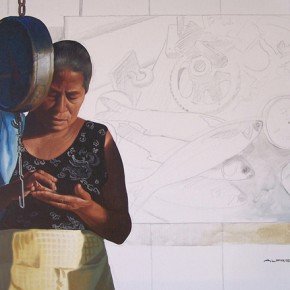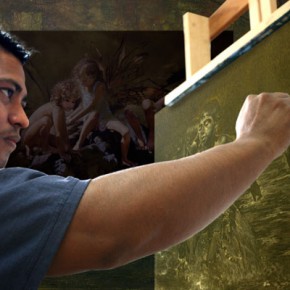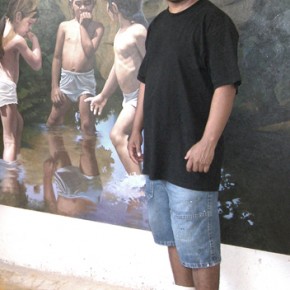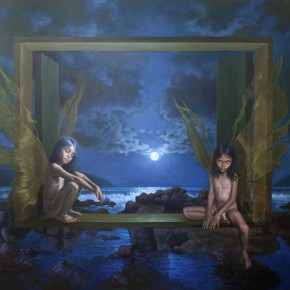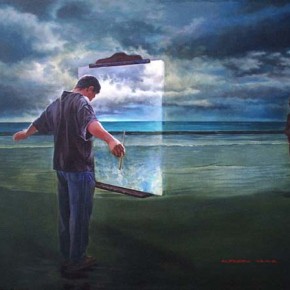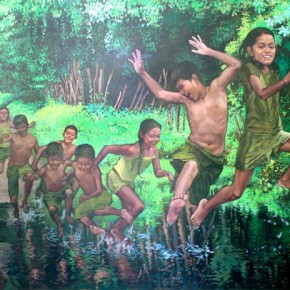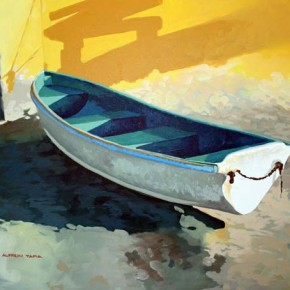When one gets into conversation with Alfredo Tapia, it does not take long to realize how much his work is his life. Not only is he prolific, he has the desire and the gift to impart his knowledge to budding artists. Born, bred and living in Zihuatanejo, he is determined to shape culture in the community.
His mission is to spread appreciation and build an art community. Art is the tangible expression of society, a mark of its health. He loves the idea that his studio is a meeting place to share ideas and develop individual techniques. Currently, his group experiments with acrylics on canvas, clay modeling, papier mâché and airbrushing. Tapia wants to dispel the notion that artists are outcasts of the working world. Many artists sit eight hours a day or more at their work. One of Tapia’s goals is to keep programs funded that train new artists who ultimately will be able to afford to live from their work.
Tapia, whose job is art, earns his ‘bread and butter’ from selling paintings, teaching art, making frames and easels for other artists, and he has illustrated a book for children published in Canada.
His photo realist skill is apparent in portraits and figures, but he prefers painting scenes from everyday life, Costumbrismo (studies of routine customs), events and rustic locations. Tapia paints many restful, idyllic scenes from nearby coastal areas: coconut trees, alive in green or boats in his favorite blues posed against the backdrop of the Zihua bay.
He claims a momentary feeling sends him to a canvas. For example, one look at his son on his bike resulted in Niño en Bicicleta. Who can say what moved him? Love for his child? The facial expression? The light? Even he could not say. Inspiration comes from anywhere, any moment, a reggae song, a sunset, stormy skies. With the primitive awareness of early cave painters, Tapia is not just interested in what he sees or knows, but also in how much he feels.
A current theme for Tapia is Cazadores Nocturnes, a series of chaneques (faeries). Chaneques exist in Mayan belief—something between a man and an angel. They are caretakers of animals and nature living where riverbeds meet the shore. If we humans abuse nature, the chaneques will punish us. (I am fast developing respect for these creatures.) Disturbing and charming is his painting, the haunting Faerie Duo. Two chaneques sit on a wooden frame, shutters open to the world, a suggestion of reality within reality. The expressions are far from angelic— cynical and sinister. Their spare underfed bodies capture the real hardships of some children’s lives in spite of these creatures being magical. This dual nature exists in many of Tapia’s works.
Magic also rears strong. Often a figure, usually a woman, is posed against a backdrop of the sea and sky. The face is missing. These paintings are not so much portraits as portrayals of mood. Sometimes, the figures are outstretched, giving a sense of freedom or relinquishing themselves to the beauty surrounding them. With color and setting, Tapia shifts mood from isolation to peace; impending storm or calm after the storm. Frequently there is a wooden frame within the framework (as in Faerie Duo), a window or a circle of floating conch shells. Symbolic of life within life, a window to the soul, magic within reality, the dualism that touches all our lives.
Tapia is working closely with four young artists, Lupita Gaitán, Mayren Navarrete, Rubi Quintana and Daniel Molina, inspiring each to develop his or her own style. They have been granted a scholarship to produce ten paintings each in ten months for a group show Arte Nativo scheduled to run in February 2009.
Art is no hobby, Tapia says more than once. He wants to see more promotion in schools for art programs. With anticipated success of his current project, he wants to show that art can be a respectable means of income equal to other occupations.
For anyone interested, Tapia gives classes Saturdays from 10:00 a.m. until 1:00 p.m. at his studio in Agua de Correa. Students often produce remarkable works in a short time: testimony to this teacher’s passion and inspiration.
His work can be found at: his gallery/studio in Agua de Correa, the Archaeological Museum and Zih Galeria in downtown Zihuatanejo. For more information on works, shows and locations go to: Galeria Arte Nativo or email: Alfredo Tapia

